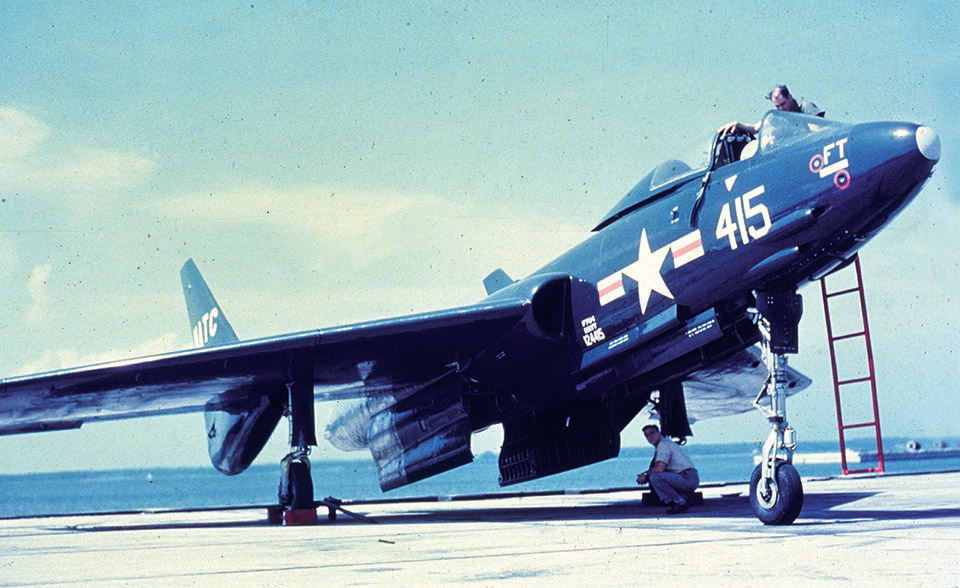The Least Successful US Navy Jet Fighter: Vought F7U Cutlass
In the early 1950s, the Chance Vought company was looking to build a new military jet fighter for the United States Navy. Inspired by the success of its fantastic F4U Corsair in World War II, the company came up with the unconventional F7U Cutlass. This aircraft first took flight in September 1948 and entered US Navy service in July 1951. It was a radical-looking aircraft that promised so much. However, it quickly became apparent that the Cutlass was a deeply flawed aircraft.
Numerous technical and handling problems plagued the aircraft throughout its service career. To make matters worse, the Cutlass was an aircraft that suffered a deadly reputation, with multiple test pilots and US Navy pilots killed by the American fighter. As a result, its retirement from service in 1959 could not come soon enough for many.
Over a Quarter of All Cutlasses Were Destroyed in Accidents
The Cutlass featured an innovative tailless design, with former Messerschmitt designer Woldemar Voigt working on the jet with Vought. He was responsible for the intriguing Messerschmitt P.1110 and P.1112 projects before the end of World War II. The swept-wing aircraft had two Westinghouse J46-WE-8B afterburning turbojets, and the aircraft had a top speed of 697 mph. The aircraft also had twin wing-mounted tailfins, and the cockpit provided good visibility for the pilot. Despite the positives, there were significant problems with the Cutlass.
The most remarkable stat is that more than a quarter of all Cutlasses built were actually destroyed in accidents. Some 78 accidents befell the Cutlass. By 1957, this made the Cutlass the aircraft with the highest accident rate of all Navy swept-wing fighters. Only aircraft like the troubled Supermarine Swift could rival the Cutlass’s reputation. The Navy found during testing that the Cutlass would gyrate after a stall. But recovering the aircraft via traditional methods didn’t work. Matters weren’t helped by the fact that the Westinghouse J34 engines of the early production versions were simply not powerful enough, hence the later J46 engines.
The Cutlass Was Severely Underpowered
Those J34 engines would appear on the very early production versions, with 14 examples built. Pilots quickly found that the Westinghouse J34 simply did not have the power for the tricky-to-fly fighter. With jet aircraft still quite raw, many early jets were troublesome to fly. Pilots would jokingly remark that the engines “put out less heat than Westinghouse’s toasters.” This also earned the aircraft some rather unfortunate nicknames, such as the “gutless Cutlass” as well as “Ensign Eliminator.” Its slightly more positive nickname was the “Praying Mantis,” but the aircraft still had its unethical reputation that it could not shake off.
One prototype crashed on July 7th, 1950. Vought test pilot Paul Thayer ejected from the Cutlass in front of an airshow crowd, the aircraft on fire prior to that ejection. The aircraft was soon seen as a “widow maker” by pilots, even if it had a stable weapons platform and was actually quite a fun jet to fly. The aircraft though still carried over its bad traits when it had entered service. Before the J46 engines, the Cutlass would have J35 engines. But these became notorious for flaming out if it was raining. The more powerful J46 engine Cutlasses became the definitive production version with 288 built.
Pilots Hated Taking the Controls of the Cutlass via the National Interest
Despite the fact it was fun to fly, pilots hated getting behind the controls of the Cutlass thanks to its awful reputation. Some notable accidents included in July 1955 with LCDR Jay T. Alkire killed in a ramp strike aboard the USS Hancock. Another pilot died when his Cutlass suffered a malfunction with the wing locking mechanism, causing it to crash into the sea. The historic US Navy Blue Angels aerobatics team also utilized the Cutlass, but a spate of accidents saw them abandon the usage of the aircraft. The poor safety record saw the US Navy replace the Cutlass with the Grumman F9F-8 Cougar.
One of the US Navy’s Deadliest Aircraft
Despite its futuristic design, its strong platform, and fun characteristics, the F7U Cutlass was nothing short of a disaster for the US Navy. By the time the aircraft retired, the Cutlass had killed four test pilots as well as 21 other US Navy pilots in its service career. Underpowered engines, weird handling characteristics, and technical issues such as with its hydraulic controls made the Cutlass a real handful. Once Vought’s F8U Crusader took to the skies, development work on the Cutlass stopped. The Crusader itself was a much safer and more capable aircraft.
Out of the 320 Cutlasses built by Vought, just seven examples survive today. The Cutlass is certainly a striking-looking aircraft, and the innovation behind its design deserves praise. But the Cutlass was nothing short of a disaster for the US Navy. Pilots were glad to see the back of it and get their hands on the more capable Cougar and Crusader.
Hits: 36









